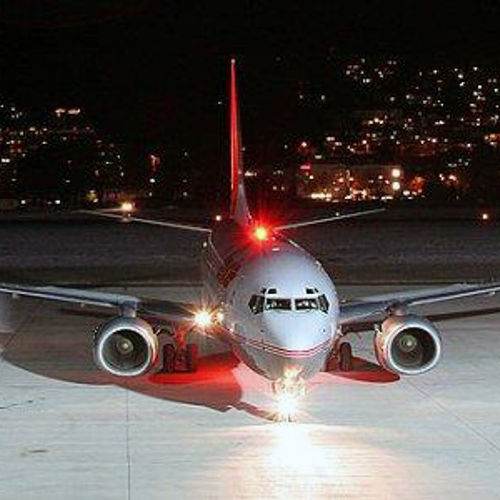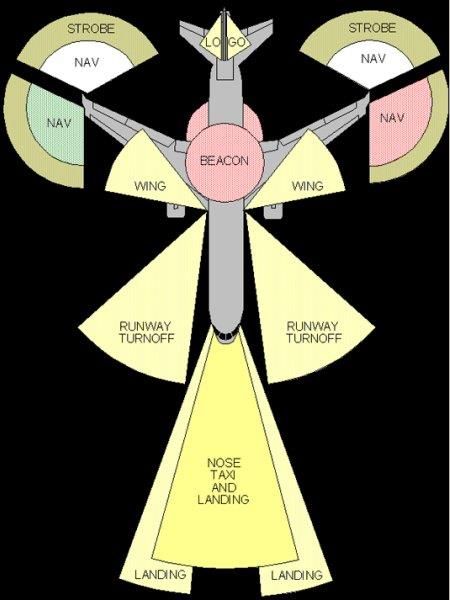
| Added | Thu, 05/01/2017 |
| Источники | Руководство по летной годности Том II Сертификация конструкции и сохранение летной годности. (Doc 9760 AN/967) Издание первое –
|
| Феномены | |
| Версии |
In connection with the feature of human vision in the dark often notice glowing objects. However, even in our age of great proliferation of aircraft some witnesses may not recognize them.
This article contains General information about the external lighting equipment aircraft and helicopters of civil aviation, the appropriate Management of airworthiness. [1]
The lighting equipment of the aircraft – side lighting device. The lighting equipment is designed to provide the crew in adverse weather flying conditions and at night, for signaling and for ground training of aircraft at night.
Depending on objectives, all lighting equipment of aircraft can be divided into three main groups [2]:
- Equipment interior lighting required to read the readings, maps, instructions, monitoring of individual devices.
- Equipment external and internal alarm, which serves to indicate the position of the aircraft or the ground and in the air, communications between the crews of aircraft with the ground to obtain information about the individual devices.
- Equipment runways and taxiways lighting that provides the pilot visibility of the landing strip and taxiways.
Interior lighting we have to consider in this article will not.
The most common variant of the external lighting of the aircraft [3].
It looks like the external lighting of the aircraft. Below we will look at it in more detail.
Aircraft
Typical lighting consists of landing, taxi and landing-taxiway lights, headlights lighting the front edge of the wing air intakes, headlights backlight insignia (emblems). The lights are retractable and non-sliding. [4]
The arrangement of lamps of external lighting of the aircraft [3].
Aircraft import and a domestic production are equipped with permanent lighting near the front edge of each wing (NAV in figure above). If you look forward (from the point of view of the pilot), the light on the right wing green and the left wing is red. The different colors allow third-party observers, such as pilots of other aircraft to determine the direction of flight. The most useful navigation lights are night to judge the direction of flight is the hardest.
In addition to the red and green lights, most planes are also fitted with white lights navigation placed in different places. In particular, large aircraft often have such lighting on the trailing edge of each wing. These lights are also sometimes placed along the rear edge of the horizontal elements of the tail. Another popular place for their location is in the rear of the fuselage or at the top of the vertical element of the tail. Installation of lights of this type are located along the center line of the aircraft, especially prevalent on small and commuter aircraft. Regardless of location, the purpose of these white lights - improve visibility of aircraft from the rear.
Two beacons are installed on the aircraft near the center of the fuselage (BEACON). One of them is on top of the fuselage and the other on its bottom. These lamps painted in red-orange color and rotate to achieve the flashing effect. The beacons are activated just before engine start and remain active until at least one of them works. Beacons serve as a warning to ground personnel that the engines are in working condition.
Strobe lights high power, flashing white light on each wing (STROBE). Most small aircraft are equipped with only one of them, near the front edge behind the red or green navigation light. Large Airliners can be also equipped with the optional flashing lamp on the rear edge. These lights are very bright and intended to attract attention during flight. Sometimes they are also used during taxiing and on the runway to make the plane more visible.
Lights logo (LOGO) are optional, but are used on most commercial aircraft. They are usually located on the surface or on the ends of the horizontal stabilizer. Permanent lights white color that are used to illuminate a company logo, depicted on the vertical part of the tail. In addition to advertising, the main purpose of these lights is improved safety, as their bright light helps to make the plane more visible.
Many aircraft are equipped with lights along the leading edge of the wing (WING), which are used to illuminate the wing and engine pylons in flight. These lights are used to make the plane more visible during takeoff and landing, and also to check the wings in flight for damage. Pilots can also use them for inspection of the wings and the ribs on the subject of icing, which could occur when flying through the clouds.
A bright white lamp taxi lamp (TAXI) located at the front nose gear of most aircraft. This lighting is typically always enabled when the aircraft is in motion on the ground, for better visibility during taxiing, take-off and landing.
Bright white landing lights (LANDING), usually installed on most planes for enhanced visibility during the landing approach. These lights can also be used for lighting of the runway at poorly lit airports. They are often required for night landings but also commonly used in the daytime to make the plane more visible. Despite the fact that the use of these lights is required, their location may vary. Landing lights can be located at the base of the wing, the outer part of the wing, or anywhere along the front of the fuselage. Some aircraft are equipped with two or more sets of landing lights, installed a few of these places.
Landing-taxiway lights (RUNWAY TURNOFF) are usually located at the front edge of the base of the wing. These bright white lamps are designed to provide side and forward lighting during taxiing and driving on the runway. These lights are useful at poorly lit airports but are usually unnecessary in normal conditions. Their light can also be used in flight if necessary to increase visibility.
Some planes are equipped with additional spotlights in the bow. These lights are designed primarily to provide illumination for ground staff pre-flight inspection of the aircraft at night. [3]
For illumination of the rod of the fuel consumer and the cone of tanker aircraft while performing air refueling in the dark on the planes in the bow can be installed lights of illumination of the rod (FFS), structurally similar to the headlamp of PRF, but less power. To indicate contact of the cone and rod the operator filling in the leading edge of the keel (forkil) refueled the plane is signal fire "coupling", white or green.
On many aircraft for illumination of the Parking lot, to perform a variety of technical work in night time are used landing-taxiing, is enabled at low power, which detrimentally affects their resource. More modern aircraft have special lower lighting groups lamps, sometimes completely on the contour of the car.
Helicopters
General information
Helicopters, light contour plane of the swept rotor are used to contour the lights. The inside end of the fairing vanes are special compact bulb type SC-88, closed transparent fairing of Plexiglas. The voltage of these lamps is 7.5 volts, which is obtained with the help of the transformer type TN-115/7,5. The power supply to the blades is made through the annular current collector on the rotor hub.
On a Russian helicopter found the application of search-landing lights type FPP-7, a feature of which is that they can not only be produced in the longitudinal plane, but also to tilt the lamp-headlight in transverse plane, which allows to illuminate the site of rescue and loading and unloading operations manufactured from a helicopter, to find a landing area at night. This is controlled by the headlight using a special four-pin with neutral pressure switch (joystick) located on the handle "STEP-GAS". In connection with the difficulty of cleaning "the nest" such lights, especially after multiple moves it in different directions, the mechanism lights FPP-7 schema is used for automatic cleaning. Light source in the lamp FPP-7 is a bulb-headlight smf-28-450. The mechanism of production-harvesting is driven by a motor SAV-8, the rotation mechanism of the optical system is driven by another motor SAV-8. [4]
The arrangement of lights exterior lighting, helicopter[5].
- Signal starboard navigation light shall be green.
- The signal of the left navigation light shall be red.
- Signal tail navigation light shall be white.
Signals lights collision warning should be flashing red. Effective frequency of flashes of the signal lights to prevent the collision must be not less than 40 and not more than 100 flashes per minute.
Identification lights medical helicopters
The lights should be blue, and the light should be flashing with the effective frequency of flashes is not less than 40 and not more than 100 flashes per minute.
Conclusion
We briefly discussed what kind of lighting equipment is usually installed on civil aircraft and helicopters.
Airplanes and helicopters for civil and military purposes can vary greatly in shape, design and equipment, but the overall principles remain the same. Here we can only add that military vehicles for better orientation in the ranks, when performing formation flight of the night used the lights of the flight systems that have a yellow or blue filters respectively, and the direction of the light flow back at an angle of 45 degrees. Also often used the location of the front lights in the form of the letter "T" on the back of the aircraft.
In this article, the data can help you identify the flying object, witness, determining the direction and nature of his movement.
Thanks
- for consultation - candidate of technical Sciences, lecturer of the Military Academy Viktor V.
- the idea of the article - Maxim Luseno
Translated by «Yandex.Translator»
Log in or register to post comments



